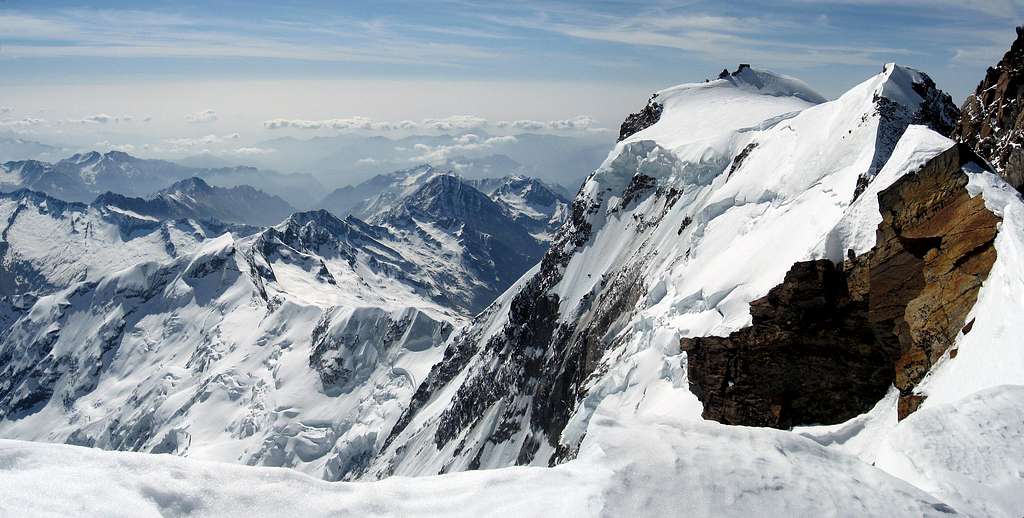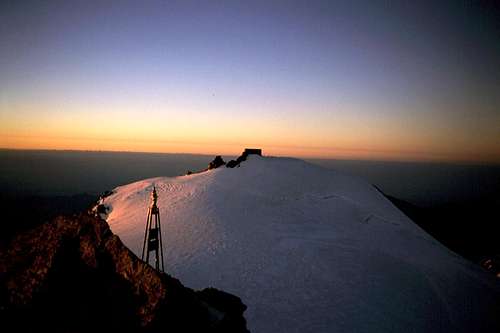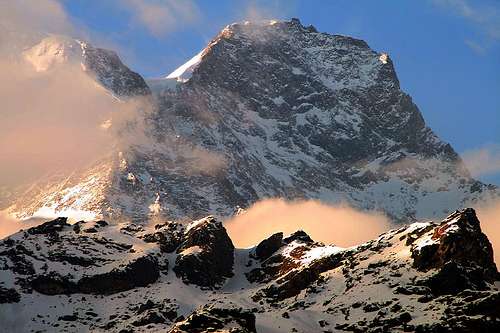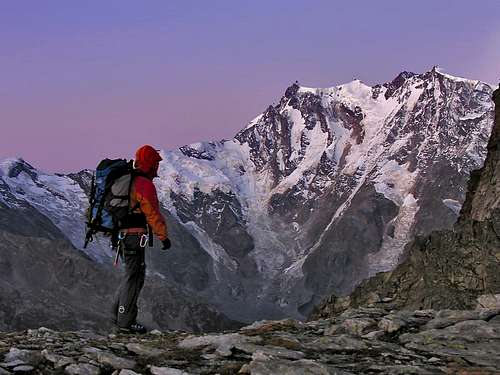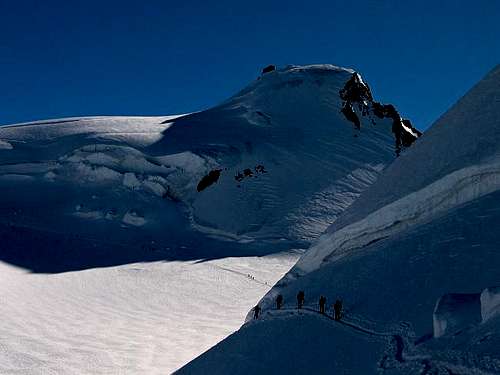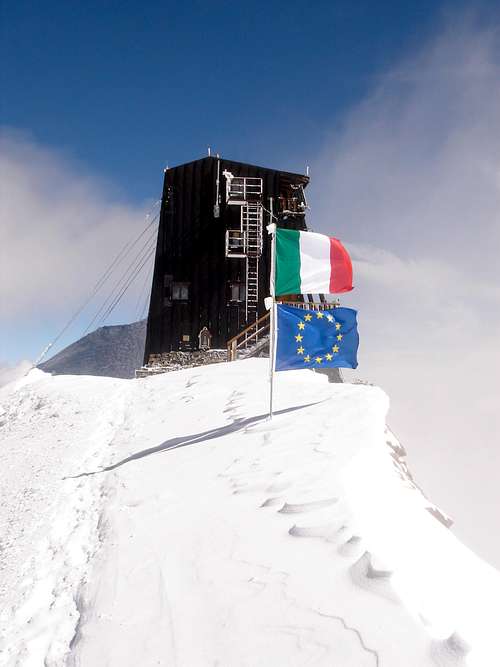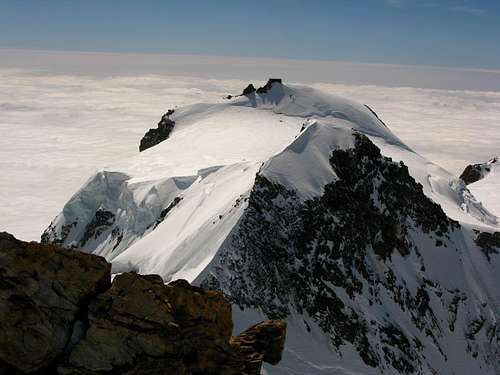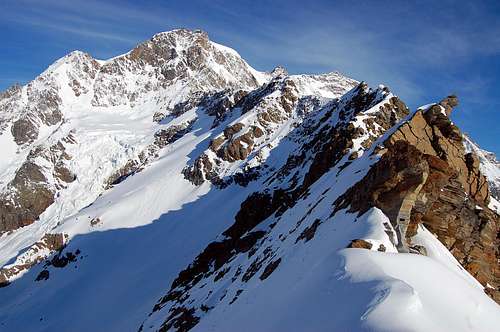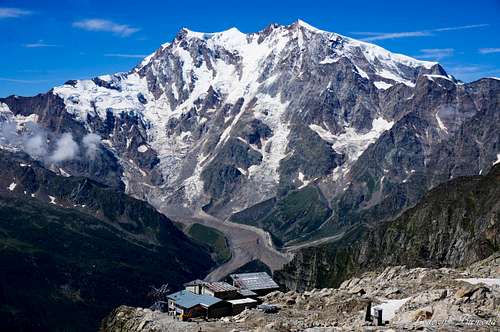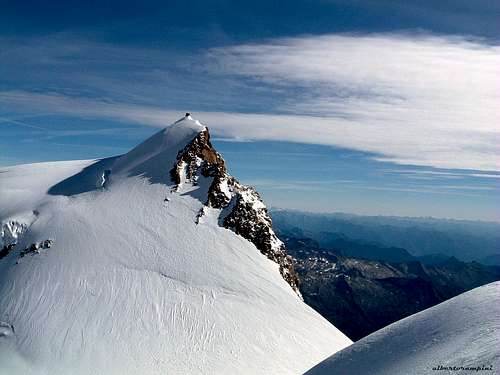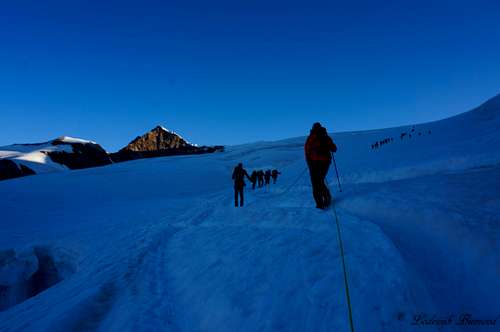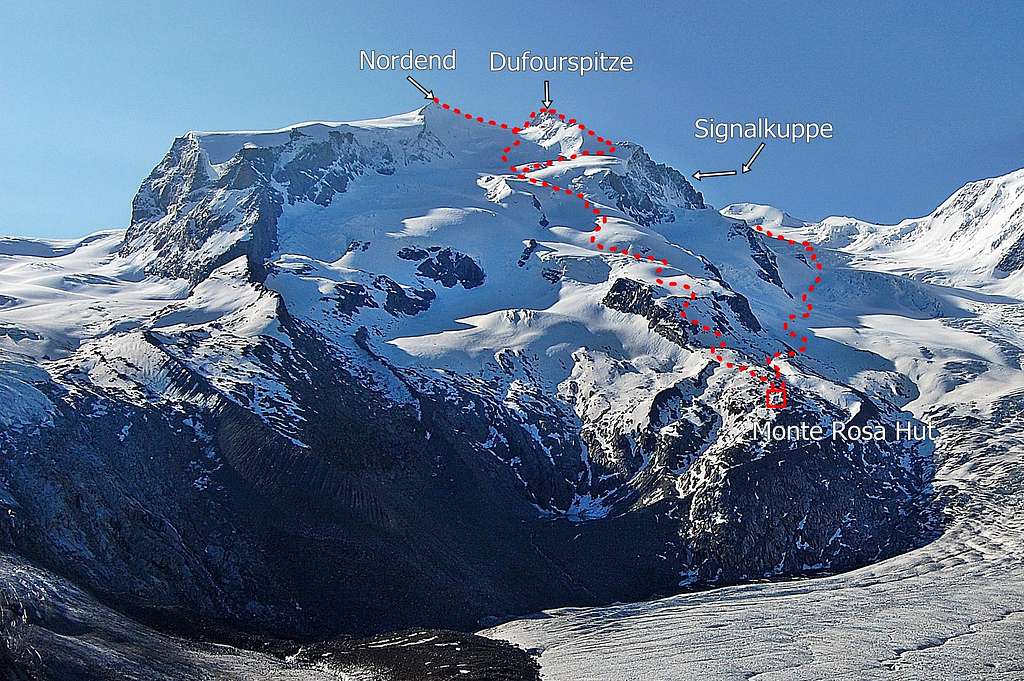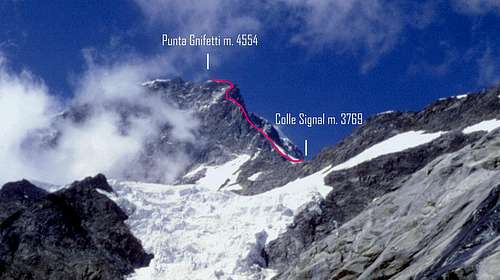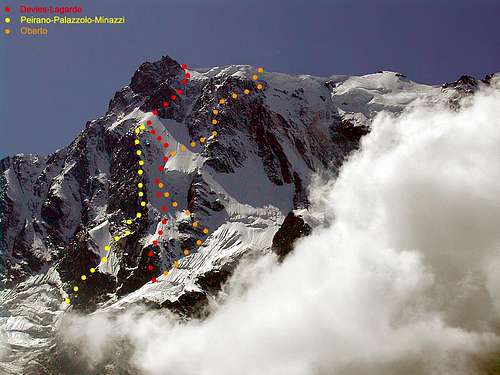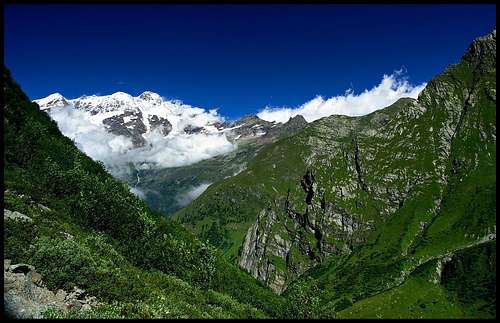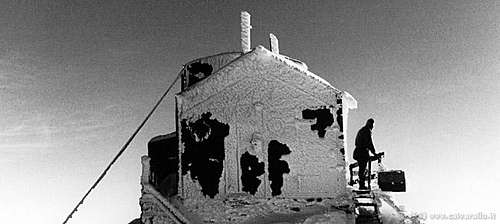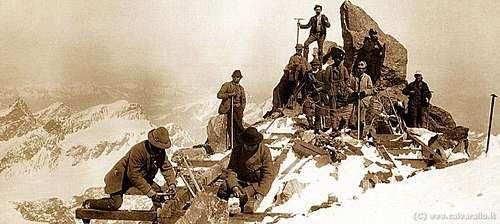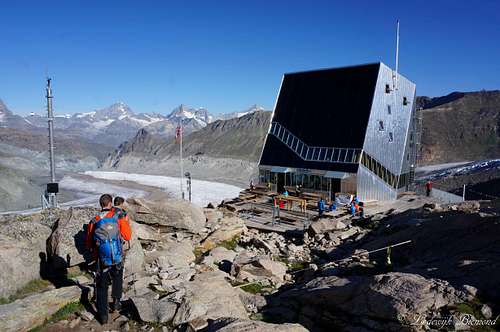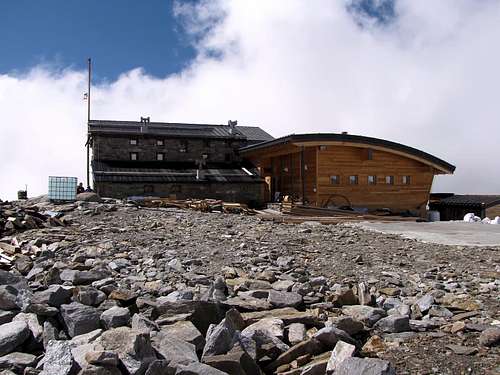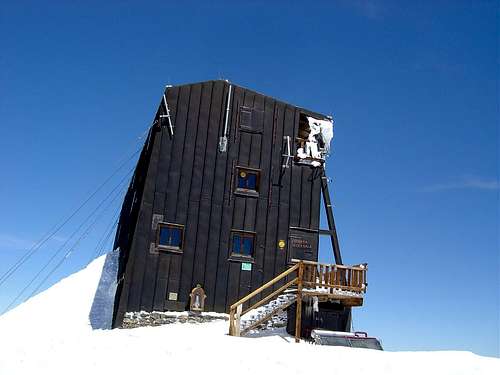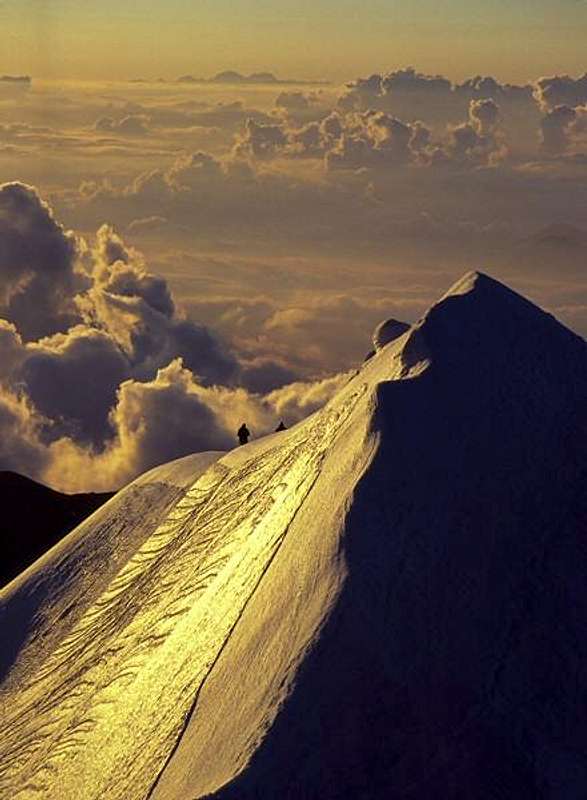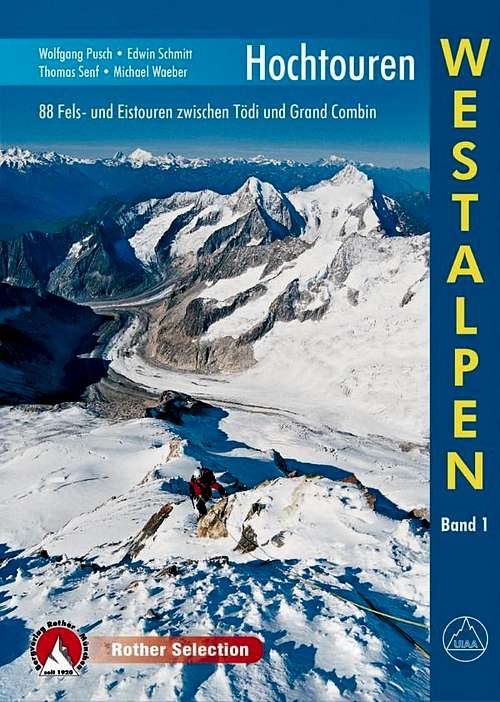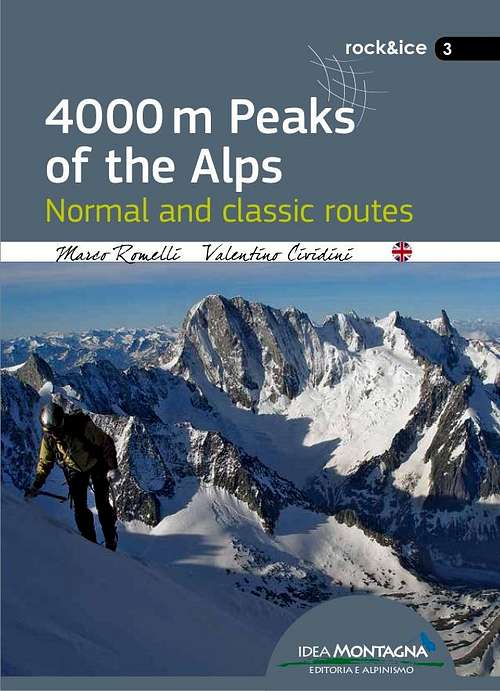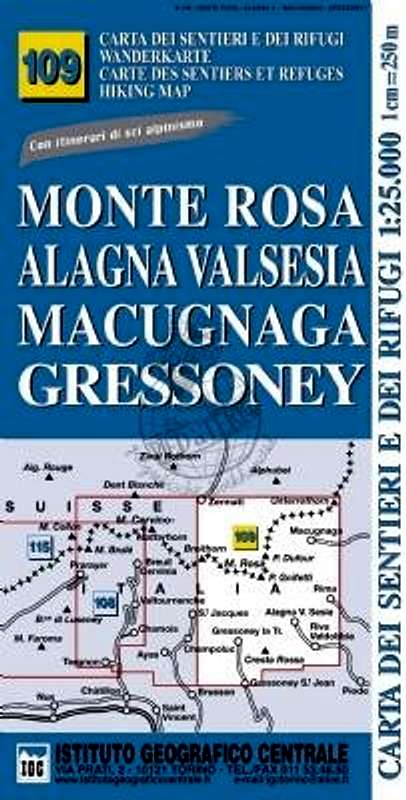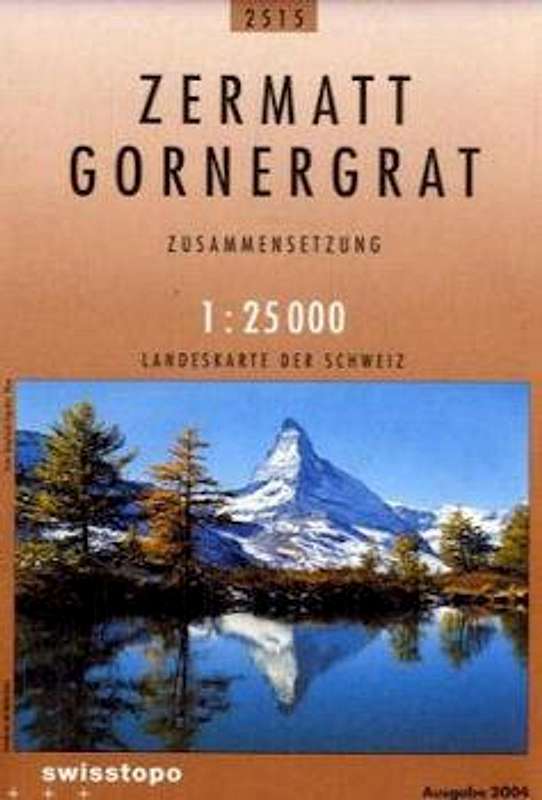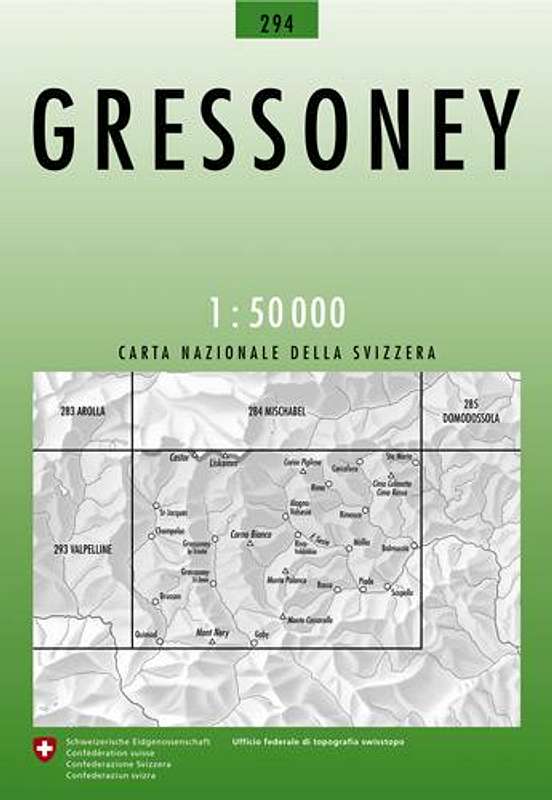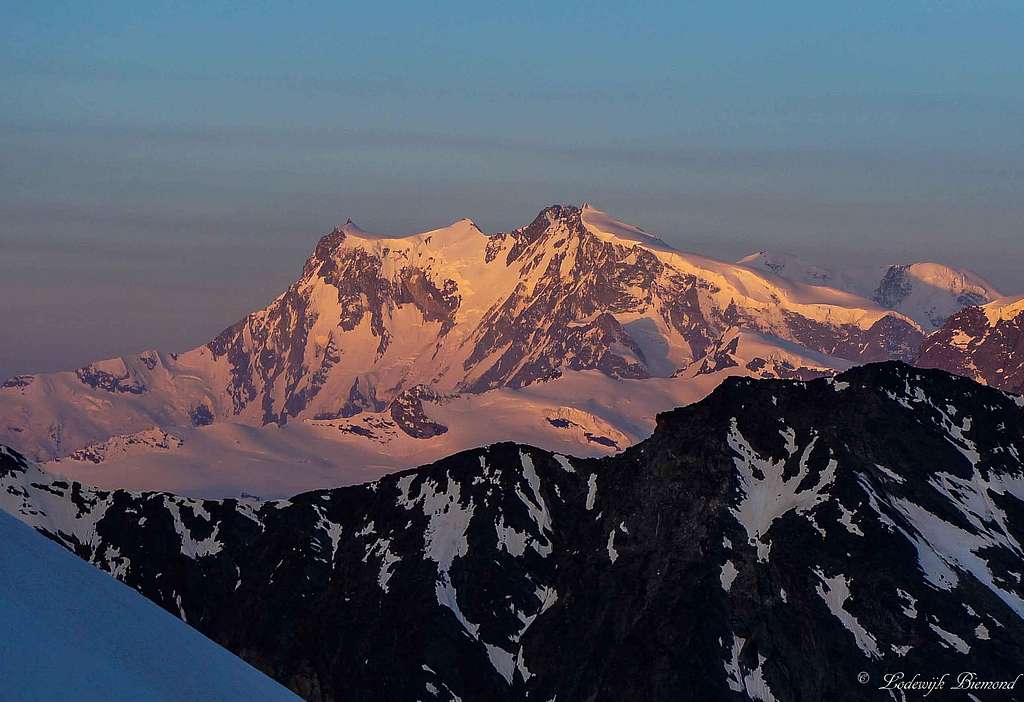|
|
Mountain/Rock |
|---|---|
|
|
45.92713°N / 7.87704°E |
|
|
Summer |
|
|
14941 ft / 4554 m |
|
|
Overview
Signalkuppe (Italian name: Punta Gnifetti) is the 6th highest mountain in the Alps and part of the Monte Rosa Group, the second highest mountain range in the Alps after the Mont Blanc Group. Signalkuppe was first climbed in August in the year 1843 by Priest Giovanni Gnifetti together with seven guides. Signalkuppe is one of the 4 Monte Rosa summits looming high above the Macugnagna valley and forming the famous Monte Rosa East wall, the biggest and highest rock face in the Alps. Signalkuppe is a popular objective for climbers, mainly because of the relative ease of the ascent (the normal route is graded PD) and being one of the 82 mountains (UIAA-list) above the magical 4000 meter barrier in the Alps. The fact that the highest mountain hut in Europe, the Capanna Regina Margherita is situated on top of the mountain, adds to its popularity. The mountain hut was named after the Italian queen Margherita who visited the "Capanna" herself.
The alpine history of the Monte Rosa began in 1778, when seven Italian climbers from Gressoney went up from south side of Monte Rosa to discover the mythical lost valley: they believed that behind the snowcapped mountains and ridges existed a paradise, full of animals and fruit trees, the ancient home of their ancestors. The highest point reached by the group (at about 4000 meters) was called "stone of the discovery". The first ascent off a Monte rosa peak was in 1801 when the preast Giordani conquered the peak now carrying his name: Punta Giordani. Other peaks were also named after their conquerors: Zumsteinspitze (Joseph Zumstein, 1820) and Pyramide Vincent (Johann Niklaus Vincent, 1819). Signalkuppe/ Punta Gnifetti was first climbed in August in the year 1843 by Priest Giovanni Gnifetti together with seven guides.
Signalkuppe / P.Gnifetti (4554m /14.941 ft) is the 6th highest mountain in the Alps (UIAA-list) after Mont Blanc (4810m /15.774 ft), Mont Blanc de Courmajeur (4748m /15.577 ft) , Dufourspitze (4634m /15.203 ft), Nordend (4606m /15.121 ft) and Zumsteinspitze (4563m/ 14.970 ft). Directly to the SW of Signalkuppe is Parrotspitze. They are separated by the Seser Joch. Directly to the NW is Zumsteinspitze, with 4563m/ 14.970 ft the 5th highest mountain in the Alps and separated from Signalkuppe by the colle Gnifetti. The western flank of the mountain is heavily glaciated with a gradual slope. The East side however, forms the highest and biggest rock face in the Alps: the near vertical Monte Rosa East wall consisting of 4 summits: Signalkuppe, Zumsteinspitze, Dufourspitze and Nordend.
There are several routes to the summit of Signalkuppe. The normal route goes up along the Italian side of the mountain and starts from either the Gnifetti or Mantova Hut. The route follows the Lys glacier up to the Lys Col and further along the western flank of the mountain to its summit. The normal route is technically easy and is fully on glaciated terrain.The overall gradation is PD. An alternative to the normal route from the Italian side is the route from the Swiss side of the mountain starting from the Monte Rosa Hut. This route is also graded PD and joins the Italian normal route after the Lys col. A classic route on the mountain is the Cresta Signal (East ridge), 800 meters high and graded D (Difficile). Other routes are the SW-ridge (D+), the SE-wall (700m,D+) and the NE-wall left spur (2500m(!), ED)
Singalkuppe / Punta Gnifetti offers fine views from its summit. Towards the north the mighty Dufourspitze and Nordend are dominating the view together with Zumsteinspitze. To the east you look down the Monte Rosa East wall towards Macugnagna, which is over 3200 vertical meters lower, down in the valley. Towards the south Parrotspitze (4436m) and Ludwigshohe (4342m) can be seen clearly. Towards the west Lyskamm (4527m) dominates the view with Matterhorn (4478m) sticking out behind.
Routes
There are several routes up to the summit of Signalkuppe. This section gives a short description of the main routes on Signalkuppe. All sections provide a link to the route pages on SP (when available). All difficulties are based on regular conditions (experienced mountaineer, good weather, no icy conditions!) as given in the guide. Note that when conditions are sub-optimal the difficulties can increase substantially.
I Italian Normal Route
The normal route to the summit of Signalkuppe starts from either the Mantova or Gnifetti Hut. The route is sometimes referred to as the Italian normal route on the mountain. The route goes fully over glaciated terrain and is technically easy. The gradation of the normal route is PD.
The time required for climbing this route is five hours from the Gnifetti hut and 30 to 45 minutes more from the Mantova Hut. Descend is the same way back, but a good alternative is to spend the night in the Capanna Regina Margherita, located onn top of the Punta Gnifetti / Signalkuppe (4554m). Although technically easy, watch out for crevasses along the route, especially on the Lys glacier. The Italian normal route is (very) popular, especially in the summer months there are many climbers on this route. Most of them climb (some of) the other 4000meter peaks along the route as well: Pyramide vincent, Balmenhorn, Corno Nero/ Schwarzhorn, Ludwigshohe and Parrotspitze.
The time required for climbing this route is five hours from the Gnifetti hut and 30 to 45 minutes more from the Mantova Hut. Descend is the same way back, but a good alternative is to spend the night in the Capanna Regina Margherita, located onn top of the Punta Gnifetti / Signalkuppe (4554m). Although technically easy, watch out for crevasses along the route, especially on the Lys glacier. The Italian normal route is (very) popular, especially in the summer months there are many climbers on this route. Most of them climb (some of) the other 4000meter peaks along the route as well: Pyramide vincent, Balmenhorn, Corno Nero/ Schwarzhorn, Ludwigshohe and Parrotspitze.
If you start your route from the Mantova Hut leave the hut in a northern direction and enter the Garstelet glacier. Cross the glacier to the north and in 30-45 minutes you will pass the Gnifetti Hut. From the Gnifetti Hut enter the Lys glacier and head up towards the north. This is a walk over fully glaciated terrain. Watch out for crevasses since the Lys glacier is filled with them. Most times a path is visible along the glacier; this is a result of the popularity of the route. All routes towards the Monte Rosa 4000m peaks go up here. Eventually you will pass Pyramide Vincent (visible to the right of you) and reach a junction of trails at about 4000m of altitude. If you take a right you go up Pyramide Vincent, if you go straight ahead, you are heading towards Signalkuppe and co. In front of you the Balmenhorn is visible (with the shelter and large Maria statue). You can ascend the saddle to the west or the saddle to the east of Balmenhorn. If you do not want to climb Balmenhorn and Corno Nero taking the western saddle is somewhat shorter. With either choice, keep heading up towards the North. Both routes meet again at the Colle de Lys, the saddle between Ludwigshohe and P.4256 at 4248m. From the Lys Col keep heading towards the North/NE and head towards the col between Zumsteinspitze and Signalkuppe, now right in front of you. At your right you will pass Parrotspitze. After reaching the col take a right and walk up along the W-NW flank and shortly you will find yourself at the entrance of the Capanna Regina Margherita and on top of Signalkuppe / Punta Gnifetti.
II from the Monte Rosa Hut
A variant from the Italian Normal route is the ascent from the Swiss side of the mountain, starting from the Monte Rosa hut. Although most people choose to ascend Dufourspitze from the Monte Rosa hut, it is a possibility to climb Signalkuppe from the Hut as well. This route is graded PD and goes almost fully over glaciated terrain and is (very) long. Starting at 2883 meters at the Monte Rosa Hut, one has to overcome almost 1700 vertical meters. Most of these meters consist of ascending the immense Grenz glacier. This route is often used as descent route coming from the Capanna Regina Margherita.
Leave the Monte rosa Hut in a south-eastern direction and follow the rocky path to point 3109. Enter the Grenz glacier and follow it upstream (towards the SE). The Grenz glacier truly is a maze filled with crevasses. Route finding can be quite difficult. Keep following the flowpath of the glacier (upstream) and you will pass Dufourspitze and Zumsteinspitze to the North of you. Keep heading up towards Parrotspitze until you reach the plateau at 4300 meters. The route now joins the Italian normal route (coming from the Gnifetti/Mantova Hut). Head towards the North/NE and head towards the col between Zumsteinspitze and Signalkuppe, now right in front of you. After reaching the col take a right and walk up along the W-NW flank and shortly you will find yourself at the entrance of the Capanna Regina Margherita and on top of Signalkuppe / Punta Gnifetti.
III Cresta Signal
A famous route on Punta Gnifetti / Signalkuppe is the Cresta Signal (Signalgrat), the East ridge leading to the summit of the mountain. The ridge starts from the Colle Signal and it separates the basin of Alagna (Valsesia) on the South-East side from the basin of Macugnaga (Valle Anzasca) on the North-East. This route is difficult and graded D (Difficile, UIAA IV-). It was first climbed by Harold W. Topham with Aloys Supersaxo and a porter on july 28th, 1887.
For more information about this route see the SP Page by member AlbertoRampini.
IV Other Routes
Routes
1)starting from Val Sesia : rif. Barba-Ferrero - canalone Sesia and SW ridge - (Motta-Gugliermina-Schiavi 1898) - D+ - SE wall - (Chiara-Guglielminetti 1906 + variants) - 700 m - D+
2)starting from Val Sesia : rif. Resegotti (3624m) - E ridge : cresta Signal - (Supersaxo-Topham 1887) - 800 m - D - a wonderful classic climb (could be compared to Cresta del Leone to Matterhorn, but without ropes)
1)starting from Val Sesia : rif. Barba-Ferrero - canalone Sesia and SW ridge - (Motta-Gugliermina-Schiavi 1898) - D+ - SE wall - (Chiara-Guglielminetti 1906 + variants) - 700 m - D+
2)starting from Val Sesia : rif. Resegotti (3624m) - E ridge : cresta Signal - (Supersaxo-Topham 1887) - 800 m - D - a wonderful classic climb (could be compared to Cresta del Leone to Matterhorn, but without ropes)
3)starting from Valle Anzasca (Macugnaga) - rif. Zamboni-Zappa (2065m)
A) NE wall left spur "via dei Francesi" - (Devies-Lagarde 1931) - 2500 m - ED - one of the most himalayan routes of the alps
B) NE wall right spur - (Zurbriggen-Pisoni 1933) - 2500 m - ?? - maybe impossible now after the big ice-rock fall
On the left on the photo the "via dei Francesi" (Devies-Lagarde - 1931) and its main variants
Approach routes
There are several ways to get to the different mountain huts from the valley. The different approach routes are described below.
I to the Mantova / Gnifetti Hut
Coming from Gressoney (Staffal)
From Gressoney, Staffal, take the cableway to the Indren glacier. The first cableway brings you to the middle station of Alpe Gabiet (there is a bar- restaurant called Rifugio Lys) a few minutes from the Gabiet Lake. The second cableway brings you to direct to Passo Salati, where you can find the new lift to Punta Indren (3250m).
From here you have to walk: you have to cross the glacier, therefore crampons are advised.
From the lift, follow the track that crosses the glacier, and in about 20 minutes you reach the place where the track splits in two, a low and a high track. Follow the low one until the end of the glacier. Go beyond a rock with fixed ropes (15 meters), than climb up again and and shortly the Mantova hut is reached. It takes about an hour from the lift to the hut.
If you choose the high track (you have to consider the season and the snow conditions), climb up slightly. When the snow ends, you go on a mixed path (earth, rocks and snow) and after a few bends you reach an equiped path. The fixed ropes and steps made with wooden trunks make your ascent of this steep section easier. When you reach the top of this path you see on the left, below, the Mantova hut. The duration is about 1 hour.
From Gressoney, Staffal, take the cableway to the Indren glacier. The first cableway brings you to the middle station of Alpe Gabiet (there is a bar- restaurant called Rifugio Lys) a few minutes from the Gabiet Lake. The second cableway brings you to direct to Passo Salati, where you can find the new lift to Punta Indren (3250m).
From here you have to walk: you have to cross the glacier, therefore crampons are advised.
From the lift, follow the track that crosses the glacier, and in about 20 minutes you reach the place where the track splits in two, a low and a high track. Follow the low one until the end of the glacier. Go beyond a rock with fixed ropes (15 meters), than climb up again and and shortly the Mantova hut is reached. It takes about an hour from the lift to the hut.
If you choose the high track (you have to consider the season and the snow conditions), climb up slightly. When the snow ends, you go on a mixed path (earth, rocks and snow) and after a few bends you reach an equiped path. The fixed ropes and steps made with wooden trunks make your ascent of this steep section easier. When you reach the top of this path you see on the left, below, the Mantova hut. The duration is about 1 hour.
To reach the Gnifetti Hut from the Mantova Hut you have to cross the Garstelet glacier. This will take up to 30 minutes longer.
Fore information about the cableway to Indren from Gressoney (including prices, timetable) see this link
Coming from Alagna
From Alagna take the cableway system to Passo Salati (it consists of two sections: the cableway (1st part) to Pianalunga and then the cableway that bring you to the Passo Salati (2nd part). From here it is a 100m walk to the new Punta Indren cableway. Once reached Indren (3250m) you follow the same path as described above.
Otherwise, from Gabiet, follow the old path 6a to reach the hut on a very safe and well-marked path. The last part of the path is on stony ground.
The way from Gabiet to Mantova hut takes about 4-5 hours. To reach the Gnifetti Hut you have to cross the Garstelet glacier. This will take up to 45 minutes longer.
Fore information about the cableway to Indren from Alagna (including prices, timetable) see this link
II to the Monte Rosa Hut
Take the Gornergratbahn (Mountain Railway) from Zermatt station to Rotenboden (2819m). From here a marked trail heads ESE following the flowpath of the Gorner Glacier. The final descent to the glacier involves down-climbing steep slabs using ladders and chains and finally crossing a small metal bridge to reach the ice at about 2500m. The trail on the glacier is well marked with flags and poles. Roping up is advisable. The glacier (ice!) is covered with a fine layer of grit so crampons are not obligated, but still, I would recommend using them.
The route crosses the junction of the Gorner and Grenz Glaciers, before following the eastern flank of the Grenz Glacier. The route leaves the ice and goes over into a marked trail, which goes straight up to the Monte Rosa hut. Total time is about 3 hours from Rotenboden.
How to get there
If you plan on climbing Signalkuppe from the Swiss side (via Monte Rosa hut or via Klein Matterhorn) Zermatt is the place to start from. Klein Matterhorn is often used as starting point for a multiple day tour ("Spaghetti tour") climbing 10 to 12 4000-meter peaks including Signalkuppe. When you plan on climbing the mountain from the Italian side the Mantova or Gnifetti Huts are used as a base. Both huts can be reached from either Alagna (Valsesia) or Gressoney. The links below provide a detailed description about how to get to these villages. For more information about getting to the mountain huts from the villages mentioned here, see the section "mountain huts" below. Both the link to the official internet page as well as to the SP-page provide information about getting to the hut.
How to get to Zermatt: Click Here
How to get to Alagna Valsesia: Click Here
How to get to Gressoney: Click Here
Capanna Regina Margherita
The Capanna Regina Margherita is placed on top of the "Punta Gnifetti", the highest peak in the Valsesia and was built in 1893 and renovated in 1980. With its 4554m is the highest refuge in Europe and is an important physical-meteorological observatory for the Piemonte region. Lots of scientific and medical research is done in the Refuge, having narrow bands with the University of Turin. The Capanna offers rooms with bunk beds, a bar, restaurant, shared bathrooms, 220v electric lighting, internet access, spaces reserved for scientific laboratories & researchers and last but not least, a library. The "Capanna Regina Margherita" has obtained, in 2002, the UNI EN ISO 14001, which proves its minimal impact on the surrounding environment.
It is reached by many climbers every spring and summer. Considered a target by itself, climbers use to spend the night here, more for the satisfaction of having been there at least once in their life, than for practical climbing purposes. Its location is so high, that sleeping here is seldom a pleasant experience. A sleepless night with a strong headache is very common. However, the Capanna's position with a balcony overlooking Alagna and Macugnagna, over 3000 vertical meters below, remains unmatched. Still, many climbers prefer that this shelter would not exist and left the Punta Gnifetti in its nature.
On July 14th, 1889, the Assembly of Delegates of the CAI approved the project to build a hut at over 4500 meters for "allowing mountaineers and scientists a confortable lodging at high altitude".
In 1890 the place was chosen: the Punta Gnifetti/Signalkuppe. The hut, prepared in the valley, was first transported by mules and then by men, all the way up to the summit.
The shelter was opened on September 4th 1893. A few days before, from the 18th until the 19th of August, the Queen (Margherita, were the name derives from) had spent the night in the refuge.
For more information see the SP Page by andrea.it
Mountain Huts
There are several mountain huts surrounding Signalkuppe. The Monte Rosa hut is the only Hut located on Swiss terrain. It is possible to climb Signalkuppe from the Monte Rosa Hut via the Grenz glacier. However, most people choose to climb Dufourspitze from the Monte Rosa Hut. From the Italian side of the mountain the Gnifetti and Mantova Huts are often used as a base for climbing Signalkuppe. The advantage of the Gnifetti Hut is the higher altitude and better location (closer to the mountain). These two huts are mostly used as a base for climbing Signalkuppe. The last hut is the famous Capanna Regina Margherita, the highest mountain hut in Europe at 4554 meters, situated on top of Signalkuppe. Many climbers choose to spend the night here and traverse Zumsteinspitze and Dufourspitze on the next day or descend back down to either the Italian or Swiss side of the mountain. If you plan on spending the night in the Margherita Hut, be sure to have the proper acclimatization.
Clicking on the name of the Hut in the table below directs you to the official internet page. Also the SP-link is given when available.
| Hut | Elevation | Telephone | SP_Link | Photo |
| Monte Rosa Hut | 2883m | +41 (0)27 967 21 15 | Here | |
| Gnifetti Hut | 3647m | +39 348 141 5490 | Here | |
| Rif. Mantova | 3470m | +39 016 37 8150 | Here | |
| Cap. Regina Margherita | 4554m | +39 348 141 5490 | Here |
When to climb
The best period to climb Signalkuppe is in the summer months: July, August, September.
Books
There are several books describing one or more climbing routes on Signalkuppe. The ''Hochtouren Westalpen'' by Rother Verlag is a very popular choice. This guidebook includes photos, route descriptions and detailed route maps for many climbs in the Western Alps, including Signalkuppe. For me this is the best guidebook at this moment. The ''Viertausender der Alpen'' by Dumler is a true classic. It is a 2014 reprint of one of the truly classic mountain books. The English version is still accessible as ''The high mountains of the Alps''. If you are looking for a smaller format the 4000er tourenfuhrer by Goedeke is a good choice as well. This guidebook has a description on every normal route on a 4000 meter peak in the Alps. If you are planning a ski-touring ascent of Signalkuppe the guidebook ''Walliser Alpen'' by Rother Verlag is the guide to go with. Other recent publications like ''the 4000m peaks of the Alps'' and ''Topo Verlag Walliser Alpen'' are shown below.
| Publisher | Name | Author | Year (last Print) | ISBN / EAN |
| Rother Verlag | Hochtouren Westalpen Band I | Wolfgang Pusch | 2015 | 9783763330287 |
| Rother Verlag | Viertausender der Alpen | Helmut Dumler | 2014 | 9783763374311 |
| Rother Verlag | The High mountains of the Alps | Helmut Dumler | 1994 | 9780898863789 |
| Idea Montagna | 4000m peaks of the Alps | Marco Romelli | 2015 | 9788897299585 |
| Rother Verlag | Walliser Alpen Skitourenfuhrer | Daniel Haussinger | 2012 | 9783763359301 |
| Topo Verlag | Walliser Alpen | Daniel Silbernagel | 2016 | 9783033024311 |
| Bruckmann Verlag | 4000er Tourenfuhrer | Richard Goedeke | 2015 | 9783765457616 |
Maps
There are several maps for climbing Signalkuppe. However, the only map on a 1:25.000 scale that covers all routes on Signalkuppe is the Italian Instituto Geografico Centrale (IGC) "109 Monte Rosa Alagna Valsesia Macugnaga Gressoney" map. For climbing Signalkuppe (and a Monte Rosa 4000ers tour) I would recommend this map. It is the only map that covers the entire Monte Rosa Group (the Swiss and Italian part). Other maps on a 1:25.000 scale are the Schweizer Landeskarte "1345 Zermatt" and the "2515 Zermatt Gornergrat" maps. Both are excellent, but only include the Swiss part of the Monte Rosa Group. These maps can be combined with the SLK "294 Gressoney" map, which covers the Italian part of Monte Rosa. Other options are the Kompass "Zermatt Saas Fee" and the SLK "5006 Matterhorn Mischabel" maps. Both are on a 1:50.000 scale and do not include the Italian side of Monte Rosa.
| Type | Name | Scale | ISBN / EAN | Additional Info. |
| Schweizer Landeskarte | 5006 Matterhorn Michabel | 1:50.000 | 9783302050065 | Covers_the_Swiss_side |
| Instituto Geografico Centrale | 109 Monte Rosa Alagna | 1:25.000 | 9788896455395 | Covers the entire area |
| Schweizer Landeskarte | 1348 Zermatt | 1:25.000 | 9783302013480 | Covers the Swiss side |
| Schweizer Landeskarte | 2515 Zermatt Gornergrat | 1:25.000 | 9783302025155 | Covers the Swiss side |
| Kompass Map | 117 Zermatt Saas Fee | 1:50.000 | 9783850269261 | Covers the Swiss side |
| Schweizer Landeskarte | 294 Gressoney | 1:50.000 | 9783302002941 | Covers the Italian side |
External Links
Signalkuppe / P.Gnifetti at www.4000er.de Images, routes, coordinates and more information about the highest peaks of the Alps
Signalkuppe / P.Gnifetti at Camptocamp Description of all major routes on Signalkuppe; Partly in English, mostly French
Official Website Zermatt (CH) and Alagna Valsesia (I)
Photos of all the Monte Rosa peaks: Monte Rosa 4000
Mountain Guides for climbing Signalkuppe: Guide Alpina Alagna in Alagna, Alpincenter Zermatt in Zermatt
Weather Forecast by mountain-forecast.com


